1. Introduction
People in India are choosing to travel with their pets. In the past few years, pet travel has become very popular across the country. Families no longer want to leave their furry friends behind when they go on trips.
The pet travel market in India is growing very fast. This shows that many pet owners want to take their dogs and cats with them while travelling. However, travelling with pets requires careful planning to keep them safe and comfortable.
This blog post will help you understand how to travel safely with your pets in India and where to get a Pet Travel Certificate. We will cover basically two travelling methods. One is via car, and another is via train. There are a few special rules and regulations to be followed to travelling with your pet in India
2. Understanding Indian Railways and Pet Travel
Indian Railways allows pets to travel on trains, but there are rules to follow. The railway system has rules to ensure that pets and passengers stay safe while travelling.

Types of Compartments Available for Pet Travel
- First AC Compartments: Pets can travel with their owners in First AC (1A) compartments. You must book either a 2-berth coupe or a 4-berth cabin completely for your family. This means you cannot share the compartment with strangers when travelling with pets.
- Luggage Van Option: If you cannot get a First AC compartment, your pet can travel in the luggage van. This area has special boxes called “dog boxes” where pets stay during the journey. However, pets travelling alone is not a good option.
Important Rule: Pets cannot travel in other classes like Second AC, Third AC, Sleeper Class, or General compartments.
3. Booking Pet-Friendly Compartments
Step-by-Step Booking Guide
Step 1: You need to book your first AC compartment ticket. You must have a confirmed ticket before you add a pet to your booking.
Step 2: Make sure you choose the AC first compartment ticket only. Not all trains come with a First AC compartment.
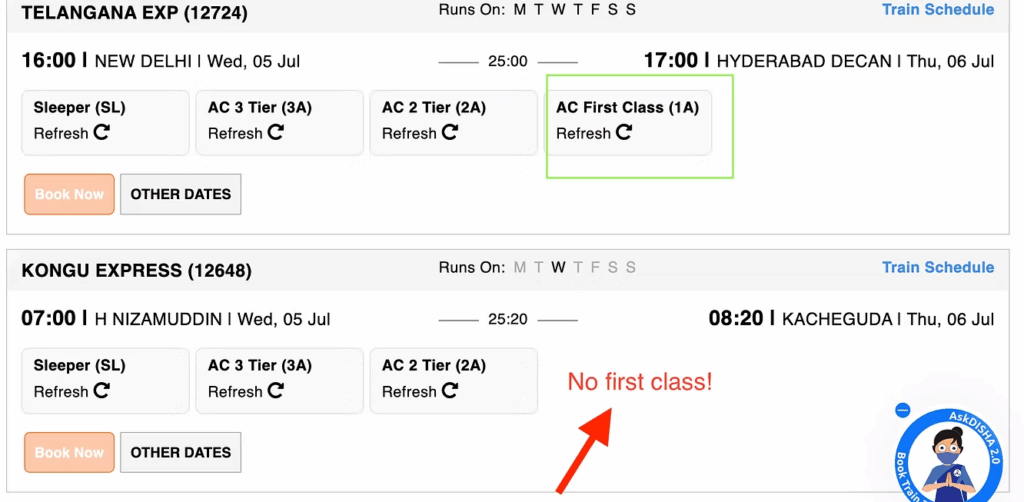
Step 3: Request a coupe or cabin when booking. Select the “Coupe” preference on the IRCTC website.

Step 4: After your ticket is confirmed, you can book your pet online through the IRCTC website. This new online system started in 2023.
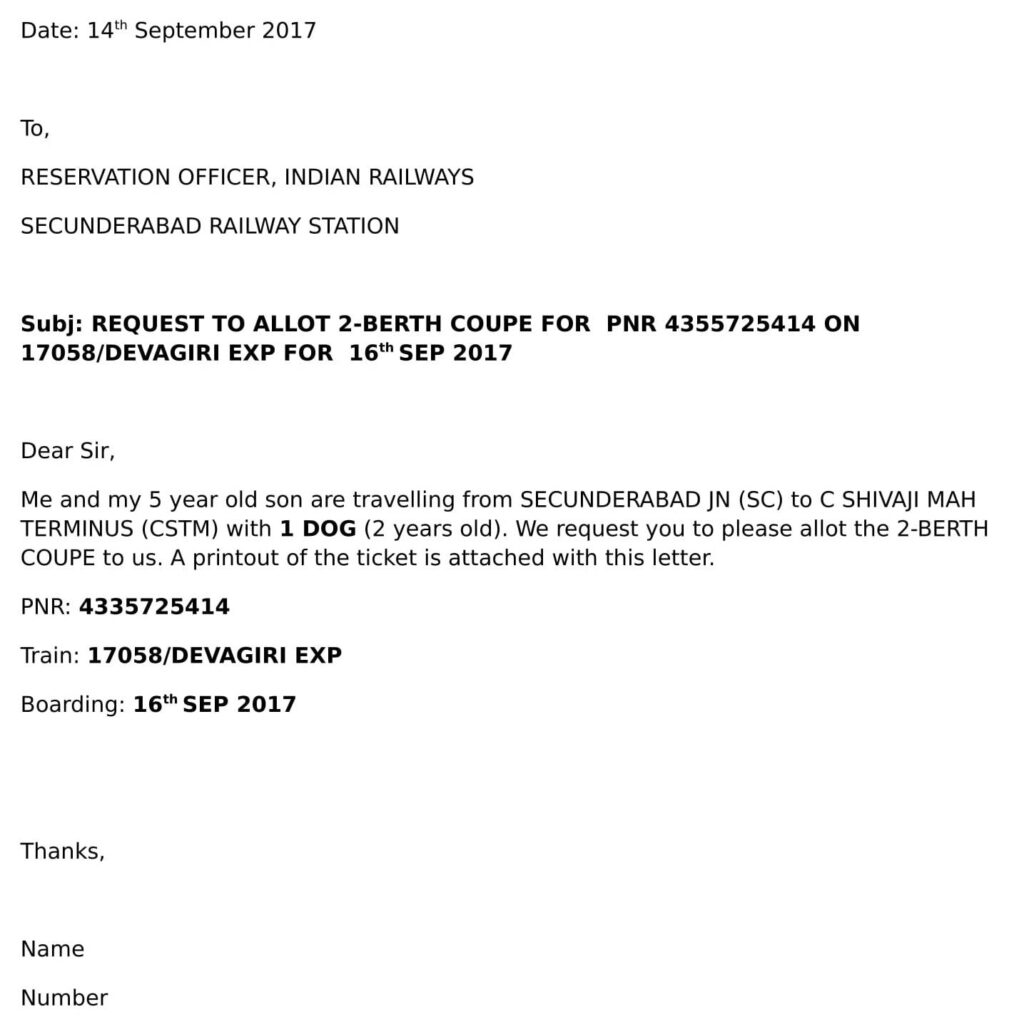
Tips for Successful Booking
- Book Early: First AC compartments are limited, so you need to book them as early as possible. Book at least 20 to 30 days in advance.
- Peak Season Planning: During holidays and festival season, the demand is very high. So you make sure that you book pets tickets very early.
- Online Pet Booking: You can only book your pet’s ticket after your ticket is confirmed and your chart is prepared, and your compartment is assigned to you.
Train Booking Charges for a Pet
Pet travel costs about ₹3,000-10,000 per pet, depending on the distance and train. This is in addition to your regular ticket price.
4. Necessary Documentation for Pet Travel
You need to make sure a few paperwork are ready with you while travelling with your pet. The documents are very important for your pet safety to follow the roadway and railway rules.
Domestic veterinary health certificate for a dog, certifying fitness for train travel in India with vaccination details and official veterinary signature.
Required Documents
- Health Certificate: Get a fitness certificate from a registered veterinarian 24-48 hours before travel. This certificate must say your pet is healthy and fit to travel. If you’re looking for a pet travel certificate near Hyderabad, do visit Petyaari Pet Clinic. The doctors at Petyaari Pet Clinic check your pet’s health. They also look at your vaccination and deworming records. If everything is in order, they give you a valid health travel certificate.
- Vaccination Records: You need to carry your pets vaccination records during your travel. You need to keep up to two years of the previous vaccination records.
- Identity Proof: Carry a valid identity proof, such as an Aadhar card, or any other valid identity proof in India.
- Train Ticket Copy: Keep a photocopy of your confirmed train ticket.
Tips for Document Organisation
- Make 2-3 copies of all documents.
- Use a waterproof folder to keep the documents.
- Carry both the original and Xerox copies.
- Store documents where you can easily reach them during the journey.
The health certificate is the most important document. Without it, your pet may not be allowed to travel.
5. Preparing Your Pet for the Journey
Getting your pet ready for train travel takes time and planning. Proper preparation helps reduce stress for both you and your pet.
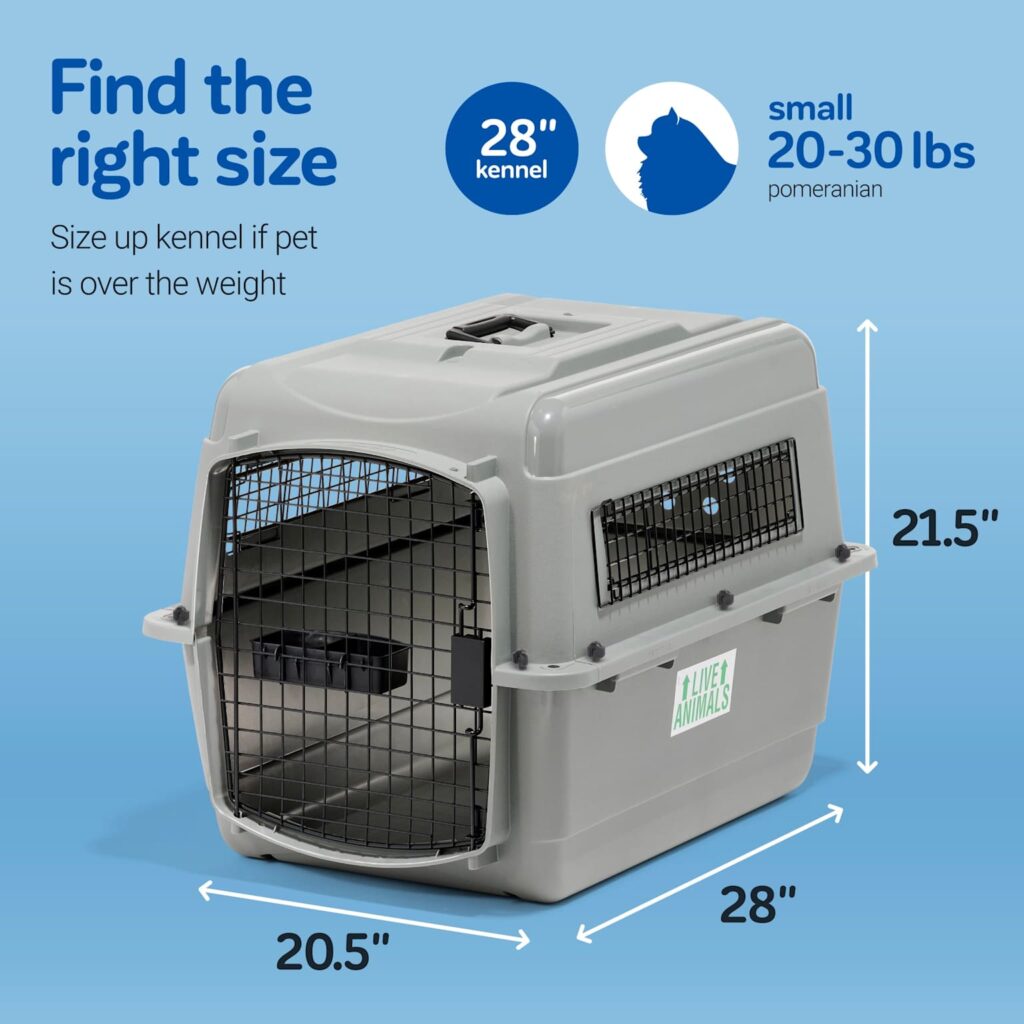
Acclimatising Pets to Travel
- Start Small: Take your pet on short car rides first. This helps them get used to movement and new sounds.
- Train Practice: Let your pet spend time in their travel crate at home. Put treats and toys inside to make it a happy place.
- Gradual Increase: Slowly increase the time your pet spends in the crate. Start with 10 minutes, then 30 minutes, then longer.
Packing Essentials
- Food and Water: Pack enough food for the entire journey plus extra. Bring familiar food to avoid stomach problems.
- Comfort Items: Pack your pet’s favourite toy, blanket, or something that smells like home.
- Cleaning Supplies: Bring waste bags, wipes, and cleaning materials.
- First Aid Kit: Pack basic medicines and bandages as advised by your vet.
Recommended Travel Gear
- Pet Carriers: Choose a well-ventilated crate that’s big enough for your pet to stand, turn around, and lie down.
- Leash and Collar: Always keep your pet on a leash during the journey. Make sure the collar has your contact information.
- Muzzle: Large dogs must wear a muzzle as per railway rules.
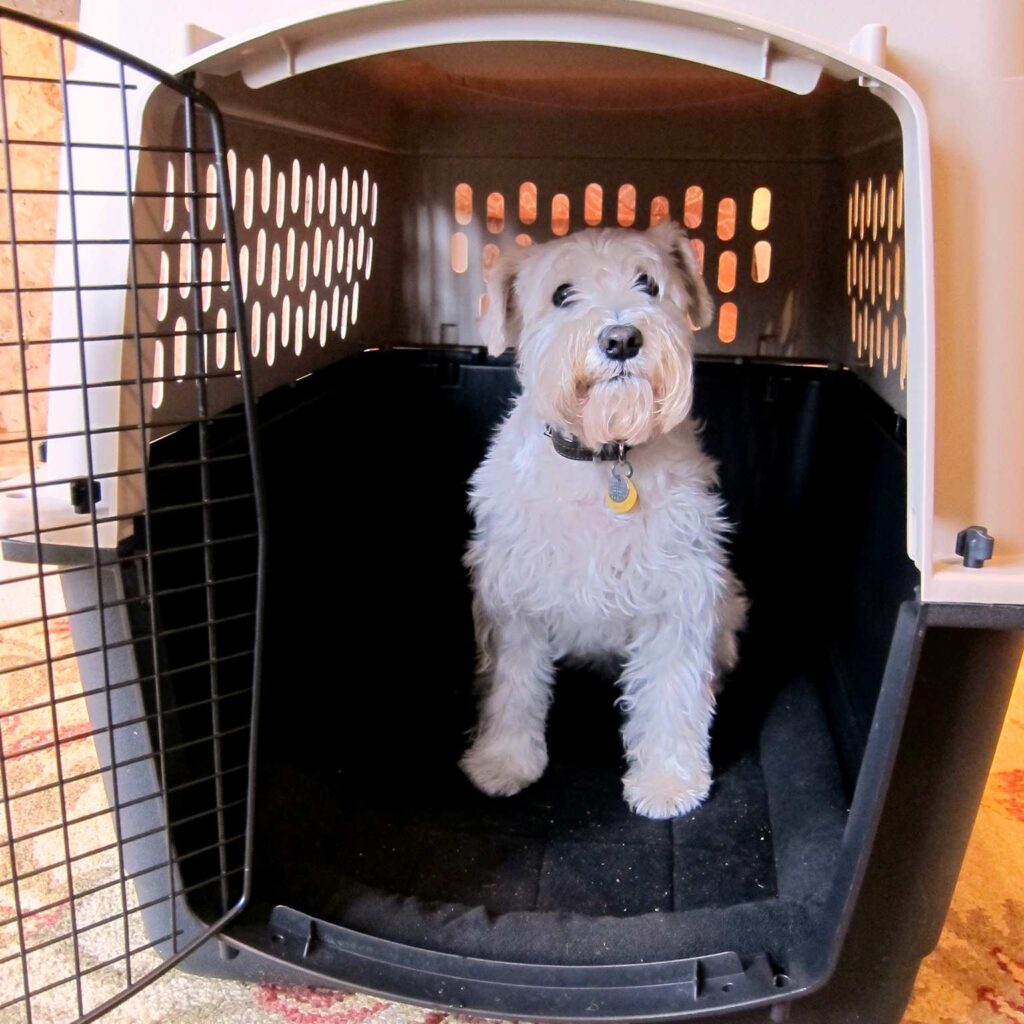
6. Safety Measures During Train Travel
Keeping your pet safe during the train journey requires constant attention and following safety rules.
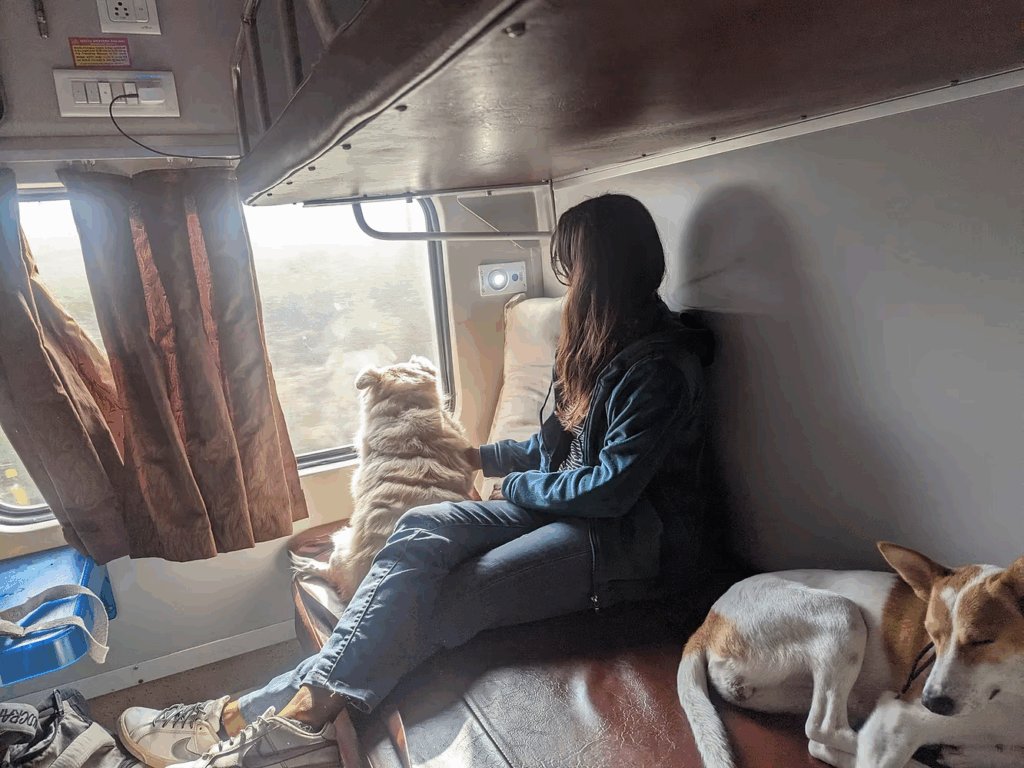
Securing Pets in Compartments
- Use a Leash: Always keep your pet on a leash, even in a private compartment.
- Crate Safety: If using a crate, make sure it’s properly secured and cannot slide around.
- Door Safety: Keep compartment doors locked to prevent your pet from wandering into the corridor.
Monitoring During the Journey
- Regular Checks: Check on your pet every hour to make sure they are comfortable.
- Watch for Signs of Stress: Look for heavy panting, drooling, or restless behaviour.
- Water Breaks: Offer water regularly, especially during long journeys.
Managing Pet Behaviour
- Stay Calm: Pets can sense your emotions. If you stay calm, your pet will feel more relaxed.
- Quiet Environment: Keep noise levels low in the compartment.
- Exercise at Stops: During long stops, take your pet for a short walk on the platform.
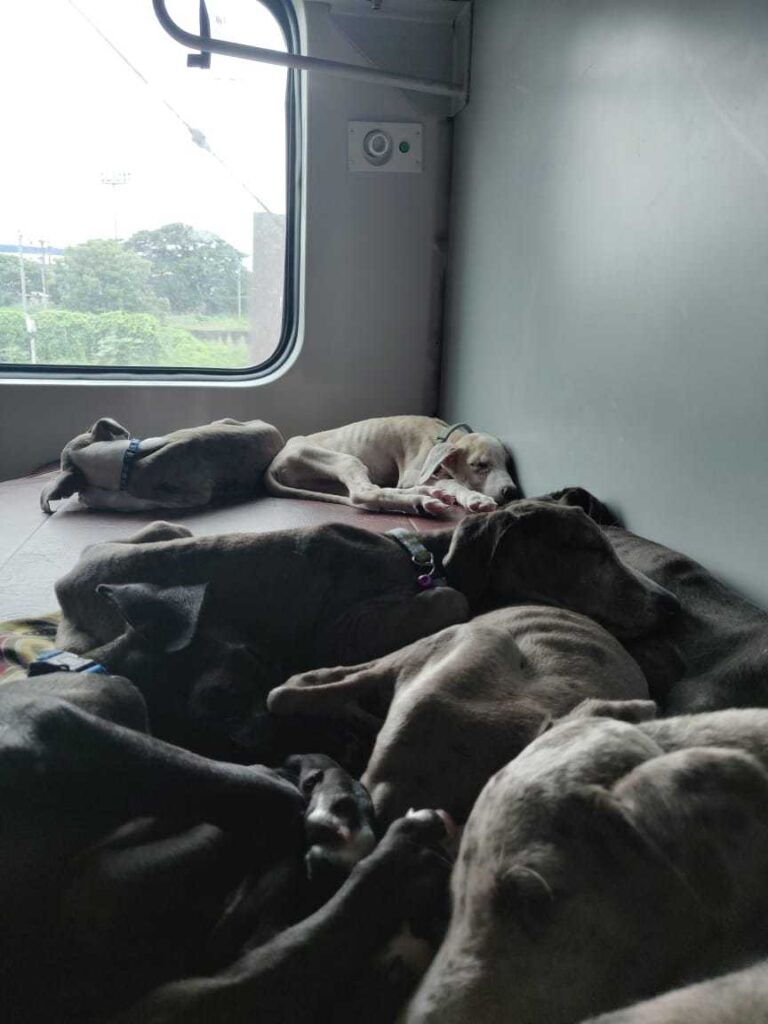
7. Dos and Don’ts of Car Travel with Pets
Car travel gives you more control over your pet’s safety and comfort. However, there are important safety rules to follow.
Key Safety Practices
- Use Pet Seat Belts: Secure your pet with a proper harness that connects to the car’s seat belt system.
- Back Seat Safety: Always keep pets in the back seat. Front seat airbags can hurt pets during accidents.
- Proper Restraints: Use crash-tested harnesses or secure carriers. Never let pets roam freely in the car.
Dos for Car Travel
- Regular Breaks: Stop every 2-3 hours to let your pet stretch, drink water, and go to the bathroom.
- Keep Cool: Use air conditioning or open windows slightly for fresh air. Never let your pet stick their head out of the window.
- Comfort Measures: Bring familiar blankets and toys to help your pet feel secure.
- Exercise Before Travel: Give your pet a good walk or playtime before starting your journey.
Don’ts for Car Travel
- Never Leave Pets Unattended: Cars can become dangerously hot or cold very quickly.
- Don’t Allow Free Roaming: Unrestrained pets can distract the driver and get injured during sudden stops.
- Avoid Feeding in Moving Cars: Don’t give food or water while the car is moving, as it can cause choking or vomiting.
- Don’t Skip Preparation: Never start a long journey without preparing your pet first.
8. Managing Pet Anxiety During Long Drives
Many pets feel nervous or scared during car rides. Understanding and managing this anxiety are important for a safe journey.
Common Signs of Anxiety
- Physical Signs: Heavy panting, drooling, shaking, or trying to hide.
- Behavioural Signs: Whining, barking, restlessness, or trying to escape.
- Digestive Problems: Vomiting, diarrhoea, or refusing to eat.
Calming Techniques
- Play Soft Music: Classical music or calming sounds can help relax anxious pets.
- Use Familiar Scents: Bring items that smell like home, such as your old t-shirt or their favourite blanket.
- Natural Calming Products: Consider pheromone sprays or calming supplements recommended by your vet.
- Pressure Wraps: Some pets feel better wearing snug-fitting anxiety wraps or “thunder shirts”.
Gradual Exposure Training
- Start with Stationary Car: Let your pet get comfortable sitting in a parked car with treats and praise.
- Short Trips First: Begin with very short drives to fun places like parks.
- Increase Distance Slowly: Gradually make trips longer as your pet becomes more comfortable.
- Positive Associations: Always end car trips somewhere enjoyable for your pet.
9. Hydration and Nutrition on the Go
Keeping your pet properly fed and hydrated during travel is essential for their health and comfort.

Importance of Hydration
- Prevent Dehydration: Pets can become dehydrated quickly during travel, especially in hot weather.
- Fresh Water Access: Always provide clean, fresh water. Use bottled water or water from home to avoid stomach upset.
- Portable Solutions: Invest in spill-proof travel water bottles designed for pets.
Feeding Guidelines
- Pre-Travel Meals: Give your pet a light meal 2-4 hours before departure. Avoid feeding large meals right before travel to prevent motion sickness.
- During Travel: For long journeys, offer small amounts of food during stops, never while the vehicle is moving.
- Familiar Food: Always use your pet’s regular food brand to avoid digestive problems.
Portable Food and Water Containers
- Spill-Proof Bowls: Use travel bowls that won’t tip over easily.
- Collapsible Options: Pack lightweight, collapsible bowls that don’t take up much space.
- Food Storage: Use airtight containers to keep food fresh and prevent spills.
- Ice Packs: For hot weather travel, pack frozen water in a travel bowl that melts gradually.
10. Conclusion
Travelling with pets in India has become much easier and more popular in recent years. With good planning, train and car trips can be safe and fun for you and your pet.
Key Points to Remember
Plan Ahead: Start preparing for your journey weeks in advance. Book tickets early, gather all documents, and get your pet ready for travel.
Follow Safety Rules: Whether travelling by train or car, always follow safety guidelines. Use proper restraints, carry required documents, and never leave your pet unattended.
Prioritise Comfort: Keep your pet comfortable with familiar items, regular breaks, and proper hydration and nutrition.
Stay Calm and Patient: Pets can sense your emotions. Staying calm and patient helps your pet feel more secure during the journey.
The Joy of Pet Travel
Travelling with pets creates wonderful memories and strengthens the bond between you and your pet. India offers many beautiful destinations that welcome pets, from hill stations to beaches. With the growing number of pet-friendly hotels and transportation options, exploring the country with your furry friend has never been better.
Remember, the key to successful pet travel is preparation, patience, and putting your pet’s safety and comfort first. When you plan properly and follow the guidelines in this blog post, you can enjoy many happy adventures together across India.
The pet travel industry in India continues to grow, making it easier for families to include their pets in their travel plans. By following these safety measures and tips, you can ensure that every journey with your pet is a positive experience for both of you.
